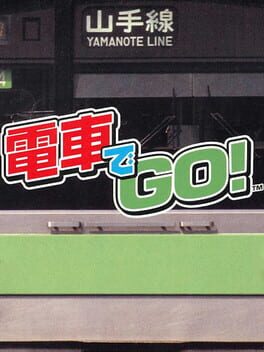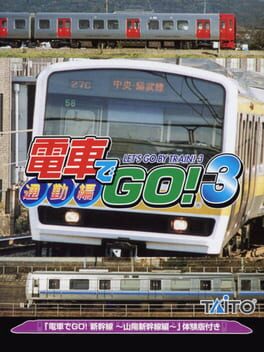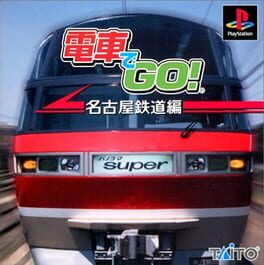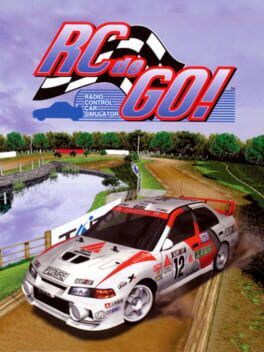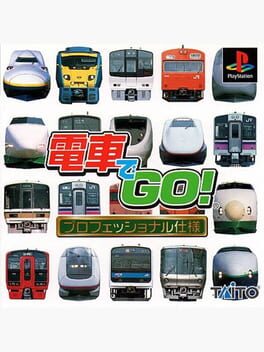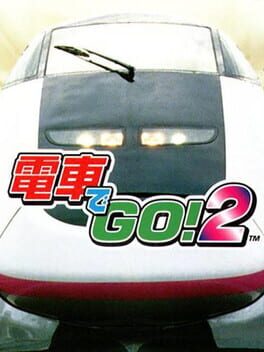

Densha de Go![a] is a 1997 train simulator arcade game developed and published by Taito in Japan. Players are tasked with guiding a train to its destination under a time limit while managing its acceleration and speed limitations. It features real-world train stations and train lines from Japan, including the Yamanote Line and Keihin-Tohoku Line. The game was ported to several home consoles, including the Nintendo 64 and PlayStation. The concept for Densha de Go! was inspired by designer Akira Saito's personal fascination with Japanese train lines and railroads. He wanted to create a game that allowed players to familiarize themselves with driving a train. The controls were his primary focus as he wanted them to be accurate and responsive, and to mimic the controls of a real train—his father worked for the Kyoto City Transportation Bureau Facilities Division, which made this easier to accomplish. Saito included real-world railroads and trains to appeal towards other railroad enthusiasts, thinking that it could also attract more "ordinary" players for its realistic, familiar theme. As arcades at the time were dominated primarily by racing and fighting games, he believed its unique concept could make it stand out. Densha de Go! is among Taito's most successful games, preceded only by Space Invaders. The PlayStation version sold over one million copies. The game was well-received by critics for its controls, attention to detail, and unique concept. Some felt that its home releases lacked enough content and had poor visuals. It was followed by a long series of sequels, spin-offs, and reimaginings, beginning with Densha de Go! 2 in 1999.
Also in series
Reviews View More
I've had my eyes on this series for quite a while, but it was only now that I finally gave this one (and train simulators, in general) a shot.
I was buying me some games on the 3DS eShop before it goes away forever by the end of March 2023, and decided to buy the entire Sonic Powered's Japanese Rail Sim 3D series (excluding two titles that were not released in the west. bummer) and, yeah, without even touching a train sim before. Call me weird.
Well, after playing a couple of rounds of the first title in that series and simply LOVING it, I knew I had to go back to the basics, and learn through Densha de GO! what made this kind of Arcade/Simulation games so special.
And, yeah, I truly enjoyed my ride with this one, with some minor caveats. It ended up to be more "arcadey" than I was expecting.
(well, it's an arcade game after all, dumbass!)
After learning how the game works through the english translation for Densha de GO! 64 (which is a port of the second game in the series), I was ready to drive here.
The game is unexpectedly fun, and the tension of making it to the next station within the schedule and stopping the train in the right spot only adds more fun to it; and, despite all that, the game is not really that mean: ok, you'll still want to be as perfect as possible to have decent scores and not be annoyed by screaming passengers and by cute lady saying how much you suck, but when you fail, you can simply continue on to the next destination, being perfectly able to just enjoy the ride and the fantastic low-poly 3D environments of real-life Japanese railways.
I kind of love and hate this aspect of the game. Whilst it makes it ultimately relaxing to play through each route, I still would prefer a more home console approach to it, since when I fail at delivering the best performance possible, I would rather have the option to retry that route until it's perfected, instead of going on with that mistake staining my final results... I guess the next entries in the series found a way to implement that into the games, but for this first one, you'll REALLY have to get good and memorise each route if you want to "fully" enjoy it.
That being said, the game is quite short, with only four main courses to go through, so if you get really invested in it, time won't be an issue for you to learn how to master Densha de GO!.
However, it will definitetly be up to you if it's worth it to stay that long with this one instead of going on and trying out the sequels, since they offer much better gameplay mechanics, more courses to play and much more interesting visuals.
This game is super fun to look at, but the sequels did a much better job in the visual department. Some of these tracks will start to look really gray and uninteresting after a while.
The ROM that I was playing was kind of messed up, and I couldn't for the life of me get the fourth course to work. For now, I'll leave it that way and jump on to the next game, but I'm definetly coming back to this one in the future (hopefully, with an english translation).
Densha de GO! is truly a very special experience. It presented me to a genre of games I would have never imagined would be engrossing enough for me to care, and made my jaw drop with it's cute arcade visuals and fun gameplay, as well as with its 80 pictures of real-life Japanese trains with trivia for each one (these also look REALLY good in the right screen, and it's nuts to think they were taken what, 27 years ago?), which put a dorky smile on my face when I found out they were in there.
Anyway, it may sound crazy, but yeah, if you like videogames, trust me: you should give this Japanese train simulator a try.
I hope it won't disappoint, but if it ever does, remember there's others in the series with much better gameplay.
And two of them translated into english! ;)
Densha de GO! IS a popular arcade series of video games in Japan, wherein one plays a satisfying and quick three-to-five minutes rounds of simple controls and precise timing. Every gauge, every meter, every number on screen has a meaning in the game and even without being able to read the Japanese you could easily figure out what it all does and how it relates to the controls. It quickly becomes intuitive, then thrilling.
One will want to perform well on these things. If one does not. If the train shoots over the edge of the station, one will be shown JUST HOW MUCH the train shot over and JUST HOW MUCH one is performing badly in comparison to others and JUST HOW MUCH money and time is being wasted in doing this. Its humiliating and infuriating, in a way pretty-much perfect for the oppressive work culture in Japan and really just in the world. Getting peer pressured into performing better every short round in it's limited few maps.
We brought up DOOM at the start because that is how we experienced Densha de GO! play a few rounds after work and dinner every day and then going on to do whatever for the rest of the day. It's nice.
